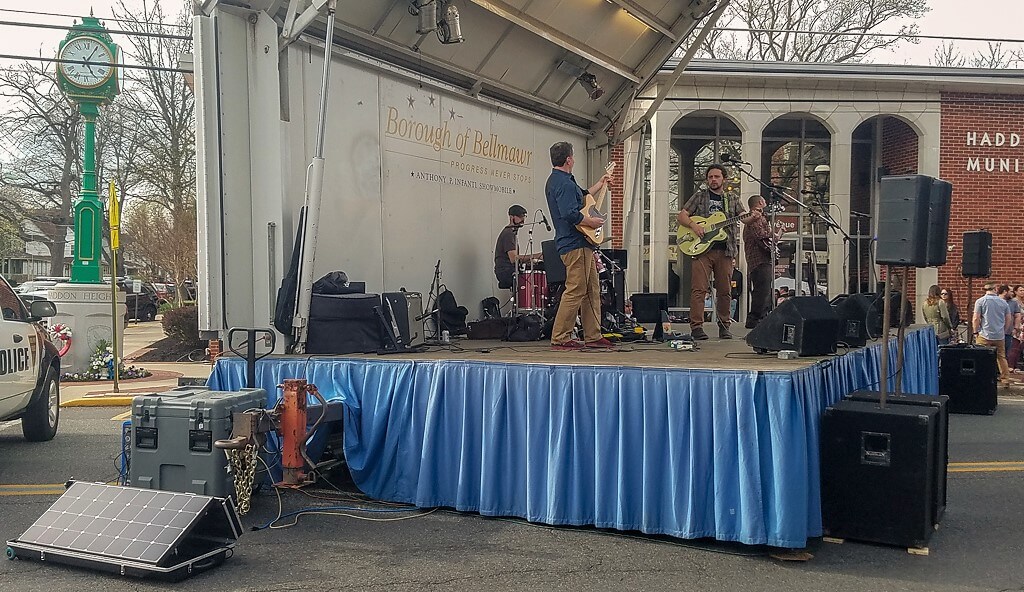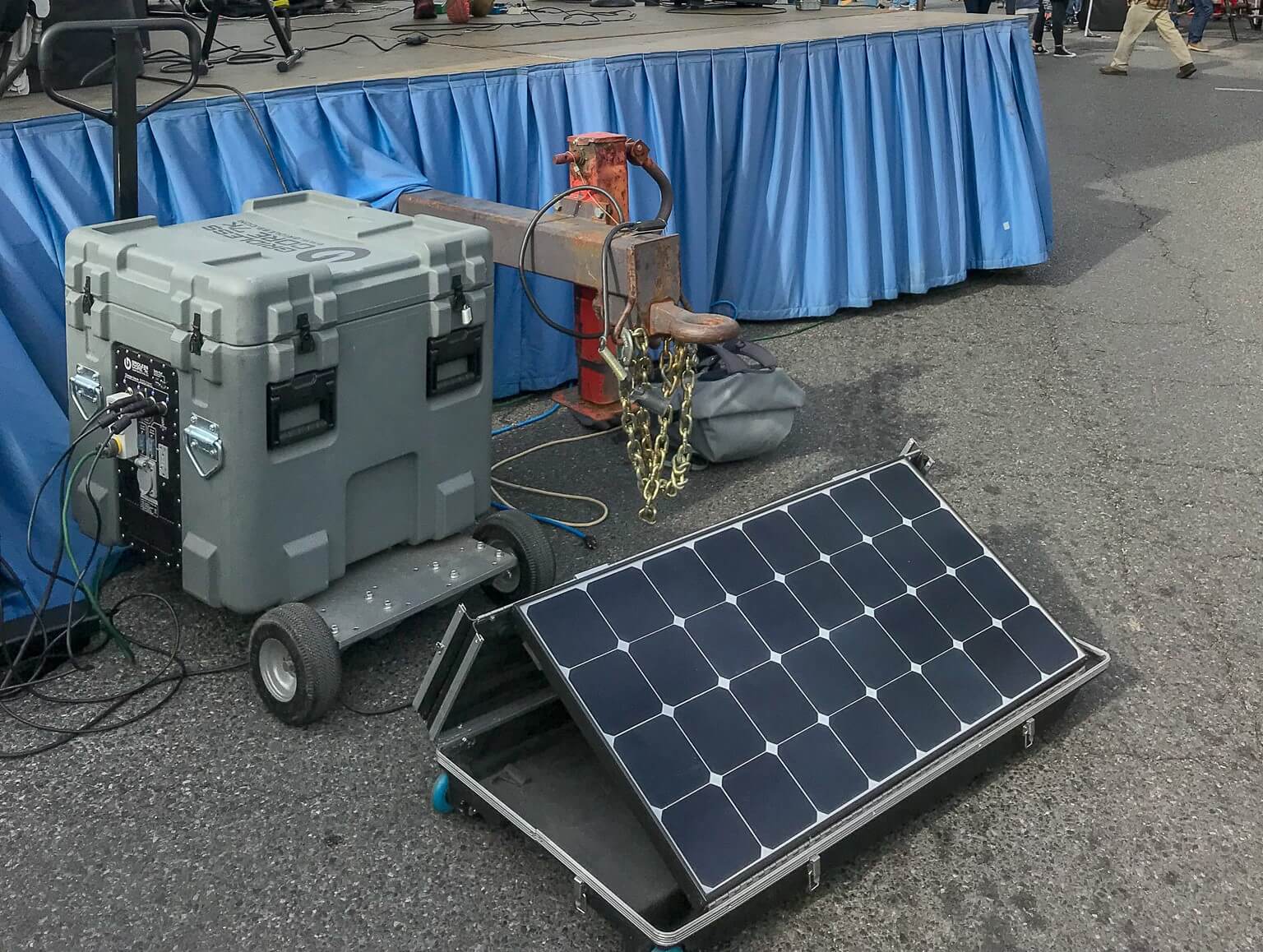Up until now, they have been the only solution for portable event power.

The Situation
There were 6 bands scheduled to play 45-minute sets. Each band had between 4 and 6 people with most groups consisting of two guitar players, a bassist, a drummer, and an occasional keyboard player.
All of the amps were cranked to about half volume and then mic’d up to the PA. The live sound setup consisted of 5 power amps powering 8 front of house PAs and 6 monitors facing back at the musicians.
Data Collection Process
In order to get an accurate reading of how much electricity each piece of gear was consuming from the battery, we placed a small sensor in between each piece of gear being powered and the battery. We measured kilowatt hours used after each set.
- Outlet 1: Guitar and Bass Amps + Pedals
- Outlet 2: Power Amps for PA
- Outlet 3: Power Amps for Monitors
We set up a microphone under the stage to record the concert, so we could get accurate start and end times for the sets.

The Gear
One of the big concerns with running audio equipment off of batteries is that audio equipment often has a very high wattage rating. The reason it can work is that equipment rarely, if ever, draws it’s rated power.
For example, a 3,000 Watt power amplifier rarely reaches 3,000 Watts in surge situations and is only that powerful in order to guarantee clean headroom for your PA speakers. Our setup at the show had 16,200 Watts of rated amplifier power. Yet, the highest non-surge reading we captured was 2,000 Watts.
So what did we end up powering?
- 1 – Yamaha LS9-16 Mixer
- 1 – Behringer ADA8200 Microphone Preamp
- 2x – Audio-Technica AEW-R4100 UHF Diversity Receiver
- 3x – QSC PLX3002 3000 Watt Power Amplifier
- 2x – QSC PLX3602 3600 Watt Power Amplifier
- 1 – Tascam CD-O1U Professional CD Player
- 1 – DBX DriveRack 260
- 4x – Electro-Voice T18 Subwoofer
- 4x – Electro-Voice Sx300
- 6x -Peavey SP-112M
Stage Gear (rotating throughout the day):
- Hartke HA400 (used all day)
- Fender Twin Reverb
- Fender Vibrolux Reverb
- 65amps Blue Series
- Boss Katana
- Fender Princeton
- Various Pedal Boards
- Various Keyboards
- Other assorted guitar amps
The Analysis
Audio Recording
We took the concert recording and threw it into our DAW Reaper to mark when musicians were actually playing. We determined that musicians were playing only when the track was clipping and that the remaining time was sound check and filler music.

- 45 minutes of sound check
- 1 hour 35 minutes of intermission music
- 4 hours 21 minutes of live music
This means that the actual performance was only being amplified 65.41% percent of the time.
Power Consumption
We took the audio data and matched it up to the measurements from our sensors in the following spreadsheet.
The guitar pedal boards barely even pulled any power. In fact, during most sets, they drew so little power that the sensors use of increments of 0.01 kWh was too large for detailed reporting.
The live sound setup draws an average of 700 Watts at performance volume. This was the primary drain on the system because it had to project the music all the way to the back of the festival. However, our Gridless 7000 was up to the task and in isolation could have powered it for 10 hours.

How Can a Small Battery System Compete With a 20kW Generator?
Generators hate variable power draw… Batteries love it.
Because batteries discharge power at a wide range of levels on command, you can use a battery that has a low inverter output and a high surge rating. In this case, we had 2 Gridless 7000 units at the event with a 7kWh capacity, a 5kW inverter, and 10kW surge. Therefore, their maximum combined power output would be 10kW with 20kW of surge allowing them to deliver as much power as 20kW generator for a short period of time.

The red line represents a traditional 20kW generator outputting a continuous 20kW in order to be ready for spikes in load. The blue line is the battery system’s output. If you notice the battery system hovers around the average 1kW and fluctuates with the load. The the area between the two lines is all of the power saved. This efficiency is what allows a small capacity battery to replace a much larger generator.
The Problem With Testing at Max Volume Using Pink Noise
The concern we always hear is how long will our system last? This goes back to the graph above. Music is not played at maximum volume at every frequency. In fact, music is very dynamic as shown by the blue line. Therefore, testing a battery’s performance with everything cranked to 11 is an ineffective way to measure its capacity in a concert situation.
If you do want to know, what a battery can power then get in contact with us here and we will work with you to configure the ideal setup.
Conclusion
No matter the use, generators are ideal power sources situations where power draw is high and steady. Halogen stage lighting for example consumes power this way and can push a concert to requiring a large generator.
Battery systems on the other hand are great at powering peaky power draws. In most small to medium sized stages, Gridless technology can replace a much larger generator and deliver clean, quiet, power while saving money on permitting and logistics.
Organizing an event and want to ditch your generator? Get in contact with us below.
How Will You Go Gridless?
Purchasing: (866) 232-8516
Purchasing: (866) 232-8516
